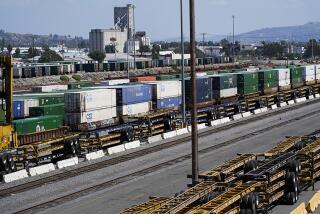Longtime Suitor Makes a Rival Bid for Conrail
- Share via
Once the castoff of a declining railroad industry in need of government help, Conrail on Wednesday became the target of rivals’ affections when Norfolk Southern made a hostile bid that tops CSX’s earlier offer by $1 billion.
News of Norfolk Southern’s $9.15-billion proposal sent Conrail’s stock up as much as 16% on the New York Stock Exchange. It later fell back slightly to close at $95.625, a gain of $10.875.
Either merger would create the nation’s third-largest railroad, a giant that would dominate the rail freight industry in the East.
Norfolk Southern’s offer would mean $100 per share in cash to Conrail stock-holders, beating the CSX offer of a cash-and-stock mix that values Conrail at about $87.68 per share based on CSX’s stock price Wednesday.
The CSX offer was initially worth $8.4 billion, but its stock price has fallen more than 6% since then, pulling down the value of the total bid to about $8.02 billion.
In a statement, Conrail said it would review the latest offer but that its board had already considered--and unanimously dismissed--the merits of a merger with Norfolk Southern over CSX. It urged shareholders to await the board’s decision.
CSX spokesman Thomas E. Hoppin said the Richmond, Va.-based company had no comment on the rival bid.
Norfolk Southern, which has been pursuing Philadelphia-based Conrail since 1984, had signaled its willingness to disrupt the CSX deal when it was announced Oct. 15.
“This proposal is better on every point than the CSX-Conrail proposal announced last week,” said David R. Goode, chairman, president and chief executive of Norfolk Southern.
If Norfolk, Va.-based Norfolk Southern won Conrail, the combination would create one of the country’s biggest railroads, matching Norfolk Southern’s strength in the Southeast with Conrail’s extensive track network in the Northeast and Midwest.
Norfolk Southern operates a 14,500-mile rail system in 20 states and Canada, as well as a trucking company.
At a meeting with analysts and the media in New York, Goode stressed that the all-cash offer was safer than the CSX bid, which is subject to fluctuations in CSX’s stock price. He said Norfolk Southern would consider launching a higher bid if CSX offered more for Conrail.
“We are in it to win,” Goode said.
Steven Lewins, an analyst at Gruntal & Co., said he doesn’t expect CSX to respond with a higher offer.
“I don’t think they have the financial wherewithal” to do that, he said.
Norfolk Southern’s stock fell 37.5 cents to close at $94.125 on the NYSE, and CSX dropped 75 cents to close at $45.50, also on the NYSE.
A combined Norfolk Southern and Conrail would, like a CSX-Conrail, rank behind Union Pacific and Burlington Northern in terms of track miles.
In a letter to Conrail’s board, Goode said Norfolk Southern would consider locating the combined company’s headquarters in Philadelphia. In its deal, CSX said the combined company would be renamed and based in Philadelphia.
Goode said he had suggested a combination as recently as 11 days before the CSX deal was announced.
“We regret that, despite knowing our long-term interest in joining Conrail with Norfolk Southern, your chairman ignored our long-standing offer to submit a business combination proposal to you,” Goode said in a letter.
The U.S. government set up Conrail in 1973 to take over the operations of Penn Central and five other “busted” railroads.
Conrail began operations in 1976 and became a publicly traded company in 1987, when the federal government sold the railroad in a public stock offering. Conrail operates an 11,000-mile rail freight network in 12 Northeastern and Midwestern states, the District of Columbia and Quebec, Canada.
CSX operates more than 18,000 miles of track running through 20 states in the East, Midwest, South and Ontario, Canada.
More to Read
Inside the business of entertainment
The Wide Shot brings you news, analysis and insights on everything from streaming wars to production — and what it all means for the future.
You may occasionally receive promotional content from the Los Angeles Times.










